CEO and Board Members' Interactions, Performance, and Stock Prices
VerifiedAdded on 2020/07/22
|7
|1783
|54
Literature Review
AI Summary
This literature review delves into the critical relationship between CEOs and board members, exploring their roles and impact on organizational success. It examines the historical context of corporate governance, highlighting the shift from founder-led firms to those managed by executives and overseen by boards of directors. The review emphasizes the CEO's increasing influence in decision-making, particularly in strategic areas, and the board's role in monitoring activities and ensuring alignment with shareholder interests. The analysis covers long-term trends in CEO and board member dynamics, including recruitment practices and the evolving balance of power. Furthermore, the review assesses the impact of CEO and board decisions on corporate performance and stock prices, considering factors like firm profitability, stability, and growth. It synthesizes research findings on how CEO expertise, board structure, and gender diversity can influence outcomes. The review concludes by emphasizing the importance of a collaborative relationship between CEOs and board members for improving corporate performance and enhancing stock market value, while also acknowledging the CEO's dominant role in many decision-making processes.
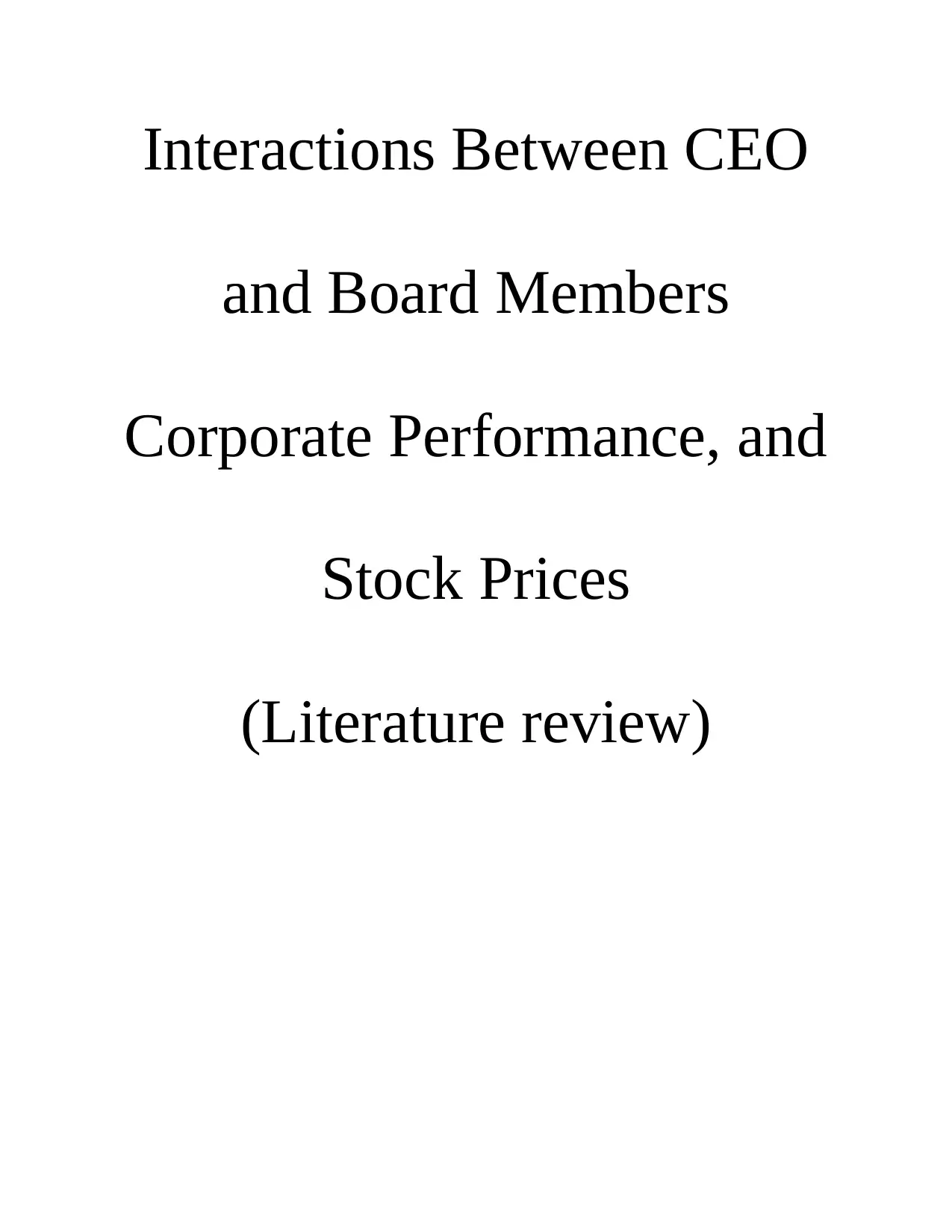
Interactions Between CEO
and Board Members
Corporate Performance, and
Stock Prices
(Literature review)
and Board Members
Corporate Performance, and
Stock Prices
(Literature review)
Paraphrase This Document
Need a fresh take? Get an instant paraphrase of this document with our AI Paraphraser

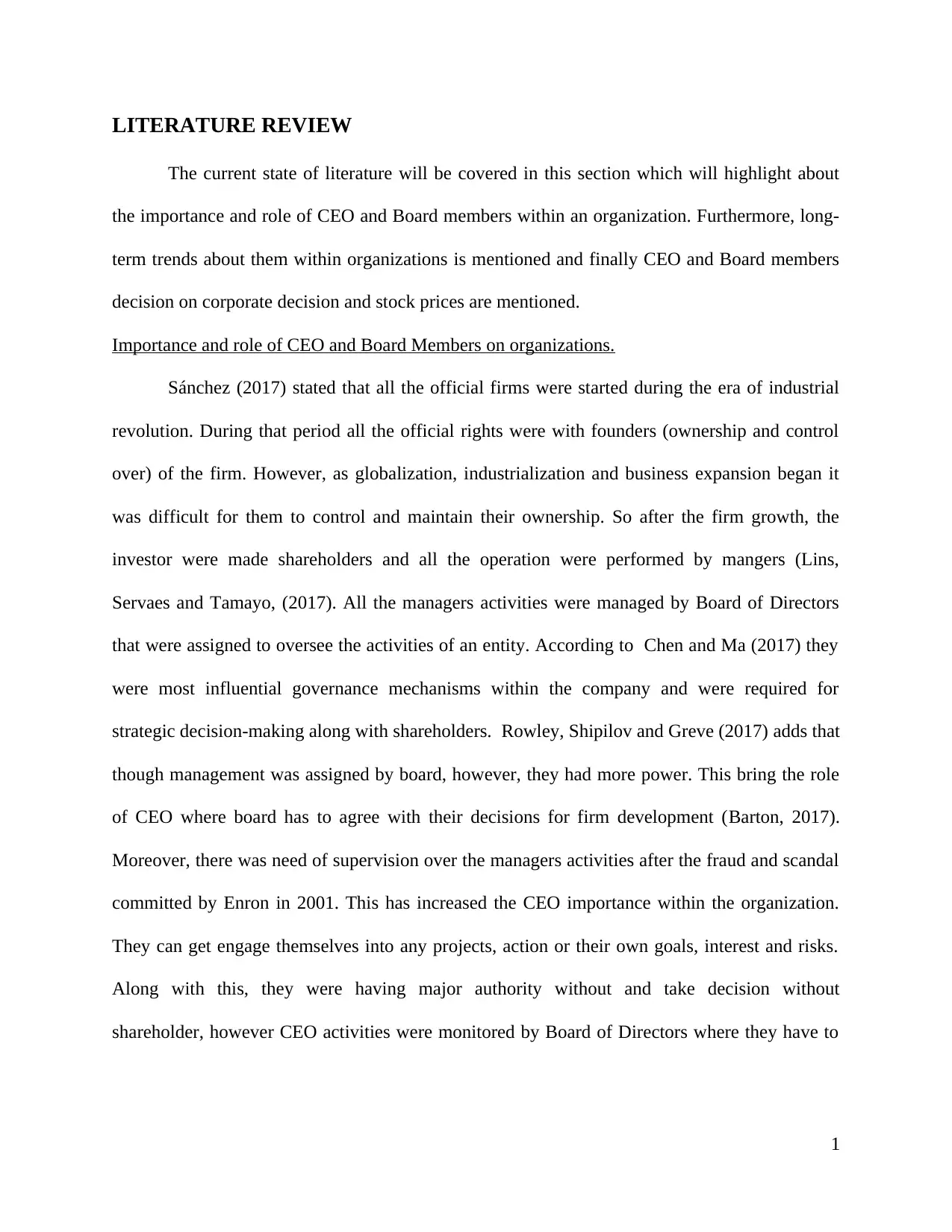
LITERATURE REVIEW
The current state of literature will be covered in this section which will highlight about
the importance and role of CEO and Board members within an organization. Furthermore, long-
term trends about them within organizations is mentioned and finally CEO and Board members
decision on corporate decision and stock prices are mentioned.
Importance and role of CEO and Board Members on organizations.
Sánchez (2017) stated that all the official firms were started during the era of industrial
revolution. During that period all the official rights were with founders (ownership and control
over) of the firm. However, as globalization, industrialization and business expansion began it
was difficult for them to control and maintain their ownership. So after the firm growth, the
investor were made shareholders and all the operation were performed by mangers (Lins,
Servaes and Tamayo, (2017). All the managers activities were managed by Board of Directors
that were assigned to oversee the activities of an entity. According to Chen and Ma (2017) they
were most influential governance mechanisms within the company and were required for
strategic decision-making along with shareholders. Rowley, Shipilov and Greve (2017) adds that
though management was assigned by board, however, they had more power. This bring the role
of CEO where board has to agree with their decisions for firm development (Barton, 2017).
Moreover, there was need of supervision over the managers activities after the fraud and scandal
committed by Enron in 2001. This has increased the CEO importance within the organization.
They can get engage themselves into any projects, action or their own goals, interest and risks.
Along with this, they were having major authority without and take decision without
shareholder, however CEO activities were monitored by Board of Directors where they have to
1
The current state of literature will be covered in this section which will highlight about
the importance and role of CEO and Board members within an organization. Furthermore, long-
term trends about them within organizations is mentioned and finally CEO and Board members
decision on corporate decision and stock prices are mentioned.
Importance and role of CEO and Board Members on organizations.
Sánchez (2017) stated that all the official firms were started during the era of industrial
revolution. During that period all the official rights were with founders (ownership and control
over) of the firm. However, as globalization, industrialization and business expansion began it
was difficult for them to control and maintain their ownership. So after the firm growth, the
investor were made shareholders and all the operation were performed by mangers (Lins,
Servaes and Tamayo, (2017). All the managers activities were managed by Board of Directors
that were assigned to oversee the activities of an entity. According to Chen and Ma (2017) they
were most influential governance mechanisms within the company and were required for
strategic decision-making along with shareholders. Rowley, Shipilov and Greve (2017) adds that
though management was assigned by board, however, they had more power. This bring the role
of CEO where board has to agree with their decisions for firm development (Barton, 2017).
Moreover, there was need of supervision over the managers activities after the fraud and scandal
committed by Enron in 2001. This has increased the CEO importance within the organization.
They can get engage themselves into any projects, action or their own goals, interest and risks.
Along with this, they were having major authority without and take decision without
shareholder, however CEO activities were monitored by Board of Directors where they have to
1
⊘ This is a preview!⊘
Do you want full access?
Subscribe today to unlock all pages.

Trusted by 1+ million students worldwide
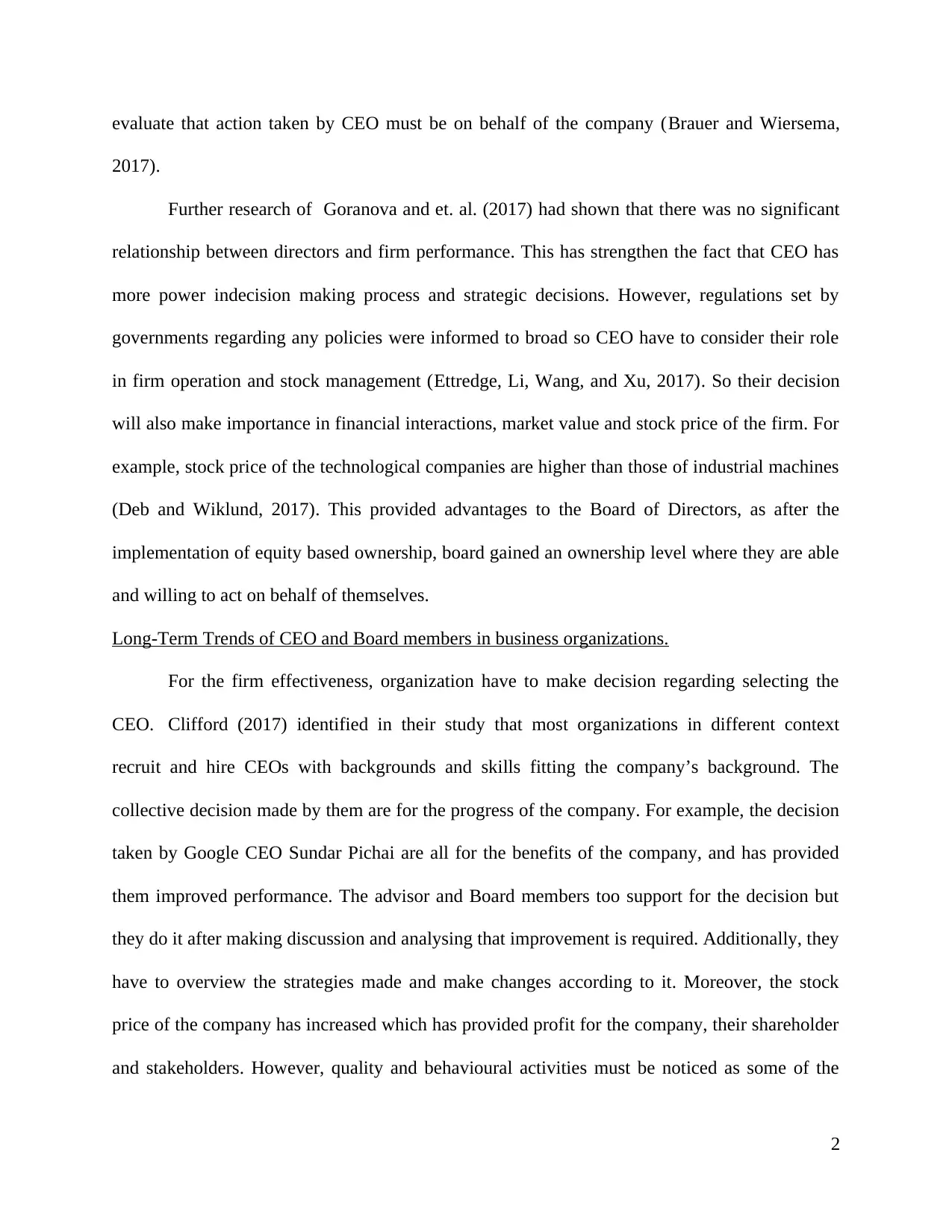
evaluate that action taken by CEO must be on behalf of the company (Brauer and Wiersema,
2017).
Further research of Goranova and et. al. (2017) had shown that there was no significant
relationship between directors and firm performance. This has strengthen the fact that CEO has
more power indecision making process and strategic decisions. However, regulations set by
governments regarding any policies were informed to broad so CEO have to consider their role
in firm operation and stock management (Ettredge, Li, Wang, and Xu, 2017). So their decision
will also make importance in financial interactions, market value and stock price of the firm. For
example, stock price of the technological companies are higher than those of industrial machines
(Deb and Wiklund, 2017). This provided advantages to the Board of Directors, as after the
implementation of equity based ownership, board gained an ownership level where they are able
and willing to act on behalf of themselves.
Long-Term Trends of CEO and Board members in business organizations.
For the firm effectiveness, organization have to make decision regarding selecting the
CEO. Clifford (2017) identified in their study that most organizations in different context
recruit and hire CEOs with backgrounds and skills fitting the company’s background. The
collective decision made by them are for the progress of the company. For example, the decision
taken by Google CEO Sundar Pichai are all for the benefits of the company, and has provided
them improved performance. The advisor and Board members too support for the decision but
they do it after making discussion and analysing that improvement is required. Additionally, they
have to overview the strategies made and make changes according to it. Moreover, the stock
price of the company has increased which has provided profit for the company, their shareholder
and stakeholders. However, quality and behavioural activities must be noticed as some of the
2
2017).
Further research of Goranova and et. al. (2017) had shown that there was no significant
relationship between directors and firm performance. This has strengthen the fact that CEO has
more power indecision making process and strategic decisions. However, regulations set by
governments regarding any policies were informed to broad so CEO have to consider their role
in firm operation and stock management (Ettredge, Li, Wang, and Xu, 2017). So their decision
will also make importance in financial interactions, market value and stock price of the firm. For
example, stock price of the technological companies are higher than those of industrial machines
(Deb and Wiklund, 2017). This provided advantages to the Board of Directors, as after the
implementation of equity based ownership, board gained an ownership level where they are able
and willing to act on behalf of themselves.
Long-Term Trends of CEO and Board members in business organizations.
For the firm effectiveness, organization have to make decision regarding selecting the
CEO. Clifford (2017) identified in their study that most organizations in different context
recruit and hire CEOs with backgrounds and skills fitting the company’s background. The
collective decision made by them are for the progress of the company. For example, the decision
taken by Google CEO Sundar Pichai are all for the benefits of the company, and has provided
them improved performance. The advisor and Board members too support for the decision but
they do it after making discussion and analysing that improvement is required. Additionally, they
have to overview the strategies made and make changes according to it. Moreover, the stock
price of the company has increased which has provided profit for the company, their shareholder
and stakeholders. However, quality and behavioural activities must be noticed as some of the
2
Paraphrase This Document
Need a fresh take? Get an instant paraphrase of this document with our AI Paraphraser
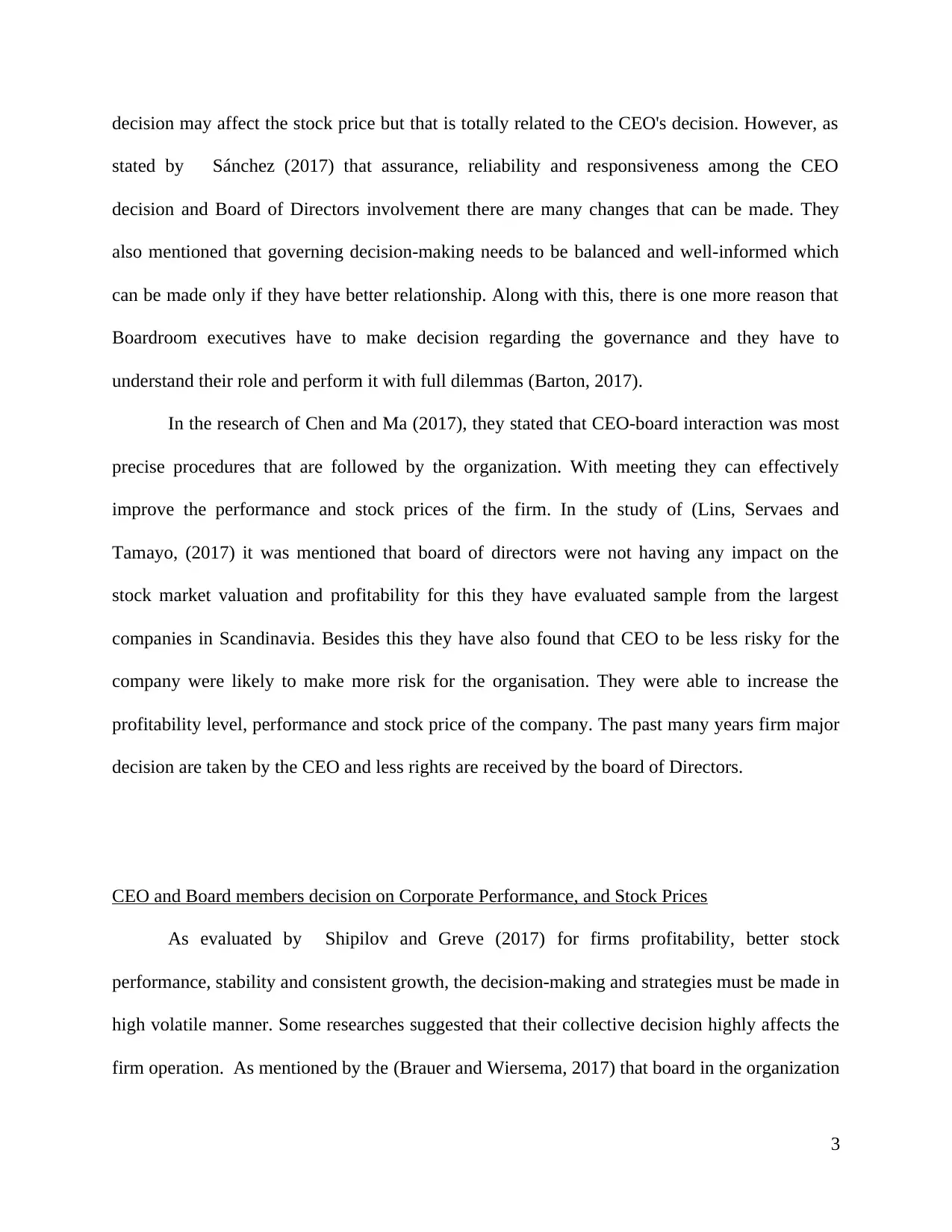
decision may affect the stock price but that is totally related to the CEO's decision. However, as
stated by Sánchez (2017) that assurance, reliability and responsiveness among the CEO
decision and Board of Directors involvement there are many changes that can be made. They
also mentioned that governing decision-making needs to be balanced and well-informed which
can be made only if they have better relationship. Along with this, there is one more reason that
Boardroom executives have to make decision regarding the governance and they have to
understand their role and perform it with full dilemmas (Barton, 2017).
In the research of Chen and Ma (2017), they stated that CEO-board interaction was most
precise procedures that are followed by the organization. With meeting they can effectively
improve the performance and stock prices of the firm. In the study of (Lins, Servaes and
Tamayo, (2017) it was mentioned that board of directors were not having any impact on the
stock market valuation and profitability for this they have evaluated sample from the largest
companies in Scandinavia. Besides this they have also found that CEO to be less risky for the
company were likely to make more risk for the organisation. They were able to increase the
profitability level, performance and stock price of the company. The past many years firm major
decision are taken by the CEO and less rights are received by the board of Directors.
CEO and Board members decision on Corporate Performance, and Stock Prices
As evaluated by Shipilov and Greve (2017) for firms profitability, better stock
performance, stability and consistent growth, the decision-making and strategies must be made in
high volatile manner. Some researches suggested that their collective decision highly affects the
firm operation. As mentioned by the (Brauer and Wiersema, 2017) that board in the organization
3
stated by Sánchez (2017) that assurance, reliability and responsiveness among the CEO
decision and Board of Directors involvement there are many changes that can be made. They
also mentioned that governing decision-making needs to be balanced and well-informed which
can be made only if they have better relationship. Along with this, there is one more reason that
Boardroom executives have to make decision regarding the governance and they have to
understand their role and perform it with full dilemmas (Barton, 2017).
In the research of Chen and Ma (2017), they stated that CEO-board interaction was most
precise procedures that are followed by the organization. With meeting they can effectively
improve the performance and stock prices of the firm. In the study of (Lins, Servaes and
Tamayo, (2017) it was mentioned that board of directors were not having any impact on the
stock market valuation and profitability for this they have evaluated sample from the largest
companies in Scandinavia. Besides this they have also found that CEO to be less risky for the
company were likely to make more risk for the organisation. They were able to increase the
profitability level, performance and stock price of the company. The past many years firm major
decision are taken by the CEO and less rights are received by the board of Directors.
CEO and Board members decision on Corporate Performance, and Stock Prices
As evaluated by Shipilov and Greve (2017) for firms profitability, better stock
performance, stability and consistent growth, the decision-making and strategies must be made in
high volatile manner. Some researches suggested that their collective decision highly affects the
firm operation. As mentioned by the (Brauer and Wiersema, 2017) that board in the organization
3
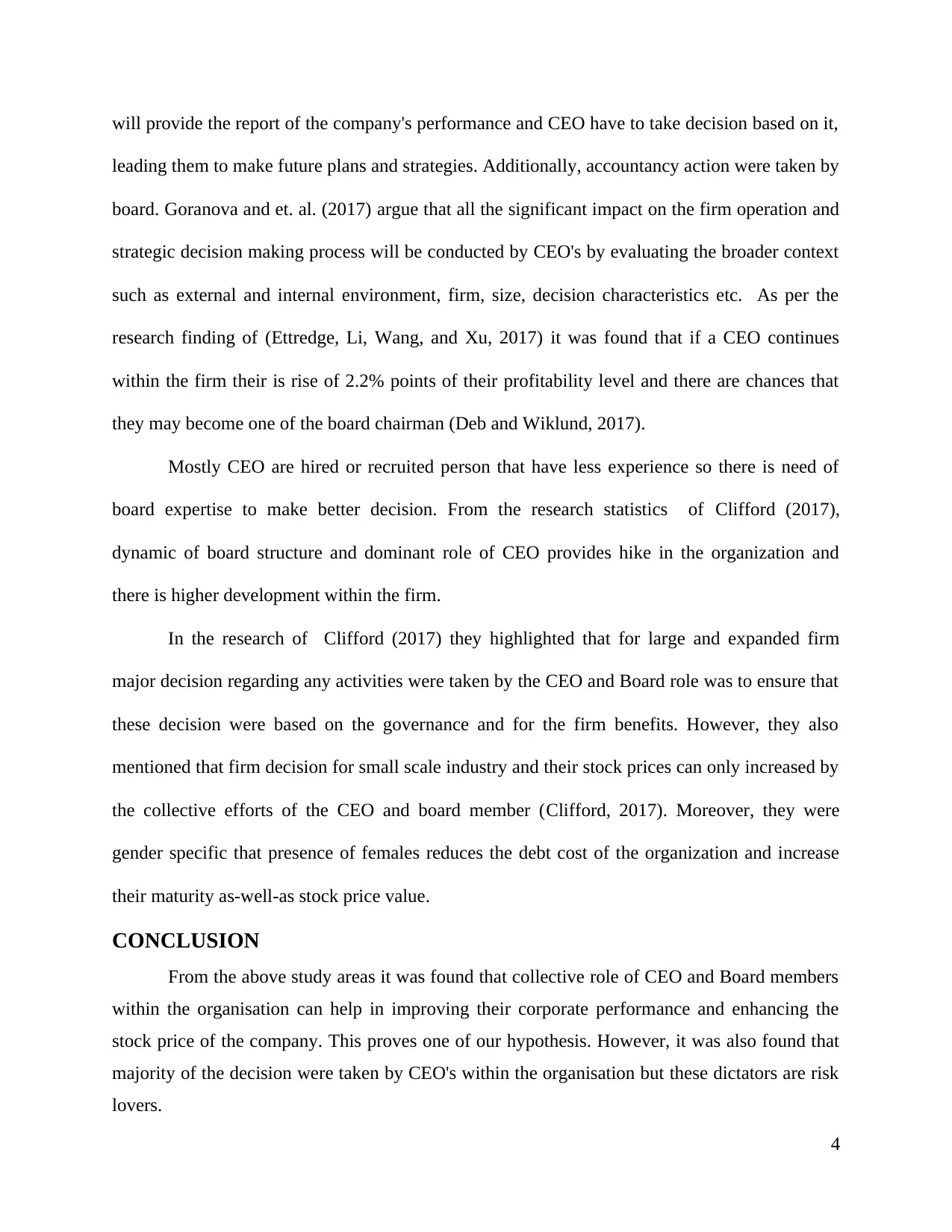
will provide the report of the company's performance and CEO have to take decision based on it,
leading them to make future plans and strategies. Additionally, accountancy action were taken by
board. Goranova and et. al. (2017) argue that all the significant impact on the firm operation and
strategic decision making process will be conducted by CEO's by evaluating the broader context
such as external and internal environment, firm, size, decision characteristics etc. As per the
research finding of (Ettredge, Li, Wang, and Xu, 2017) it was found that if a CEO continues
within the firm their is rise of 2.2% points of their profitability level and there are chances that
they may become one of the board chairman (Deb and Wiklund, 2017).
Mostly CEO are hired or recruited person that have less experience so there is need of
board expertise to make better decision. From the research statistics of Clifford (2017),
dynamic of board structure and dominant role of CEO provides hike in the organization and
there is higher development within the firm.
In the research of Clifford (2017) they highlighted that for large and expanded firm
major decision regarding any activities were taken by the CEO and Board role was to ensure that
these decision were based on the governance and for the firm benefits. However, they also
mentioned that firm decision for small scale industry and their stock prices can only increased by
the collective efforts of the CEO and board member (Clifford, 2017). Moreover, they were
gender specific that presence of females reduces the debt cost of the organization and increase
their maturity as-well-as stock price value.
CONCLUSION
From the above study areas it was found that collective role of CEO and Board members
within the organisation can help in improving their corporate performance and enhancing the
stock price of the company. This proves one of our hypothesis. However, it was also found that
majority of the decision were taken by CEO's within the organisation but these dictators are risk
lovers.
4
leading them to make future plans and strategies. Additionally, accountancy action were taken by
board. Goranova and et. al. (2017) argue that all the significant impact on the firm operation and
strategic decision making process will be conducted by CEO's by evaluating the broader context
such as external and internal environment, firm, size, decision characteristics etc. As per the
research finding of (Ettredge, Li, Wang, and Xu, 2017) it was found that if a CEO continues
within the firm their is rise of 2.2% points of their profitability level and there are chances that
they may become one of the board chairman (Deb and Wiklund, 2017).
Mostly CEO are hired or recruited person that have less experience so there is need of
board expertise to make better decision. From the research statistics of Clifford (2017),
dynamic of board structure and dominant role of CEO provides hike in the organization and
there is higher development within the firm.
In the research of Clifford (2017) they highlighted that for large and expanded firm
major decision regarding any activities were taken by the CEO and Board role was to ensure that
these decision were based on the governance and for the firm benefits. However, they also
mentioned that firm decision for small scale industry and their stock prices can only increased by
the collective efforts of the CEO and board member (Clifford, 2017). Moreover, they were
gender specific that presence of females reduces the debt cost of the organization and increase
their maturity as-well-as stock price value.
CONCLUSION
From the above study areas it was found that collective role of CEO and Board members
within the organisation can help in improving their corporate performance and enhancing the
stock price of the company. This proves one of our hypothesis. However, it was also found that
majority of the decision were taken by CEO's within the organisation but these dictators are risk
lovers.
4
⊘ This is a preview!⊘
Do you want full access?
Subscribe today to unlock all pages.

Trusted by 1+ million students worldwide
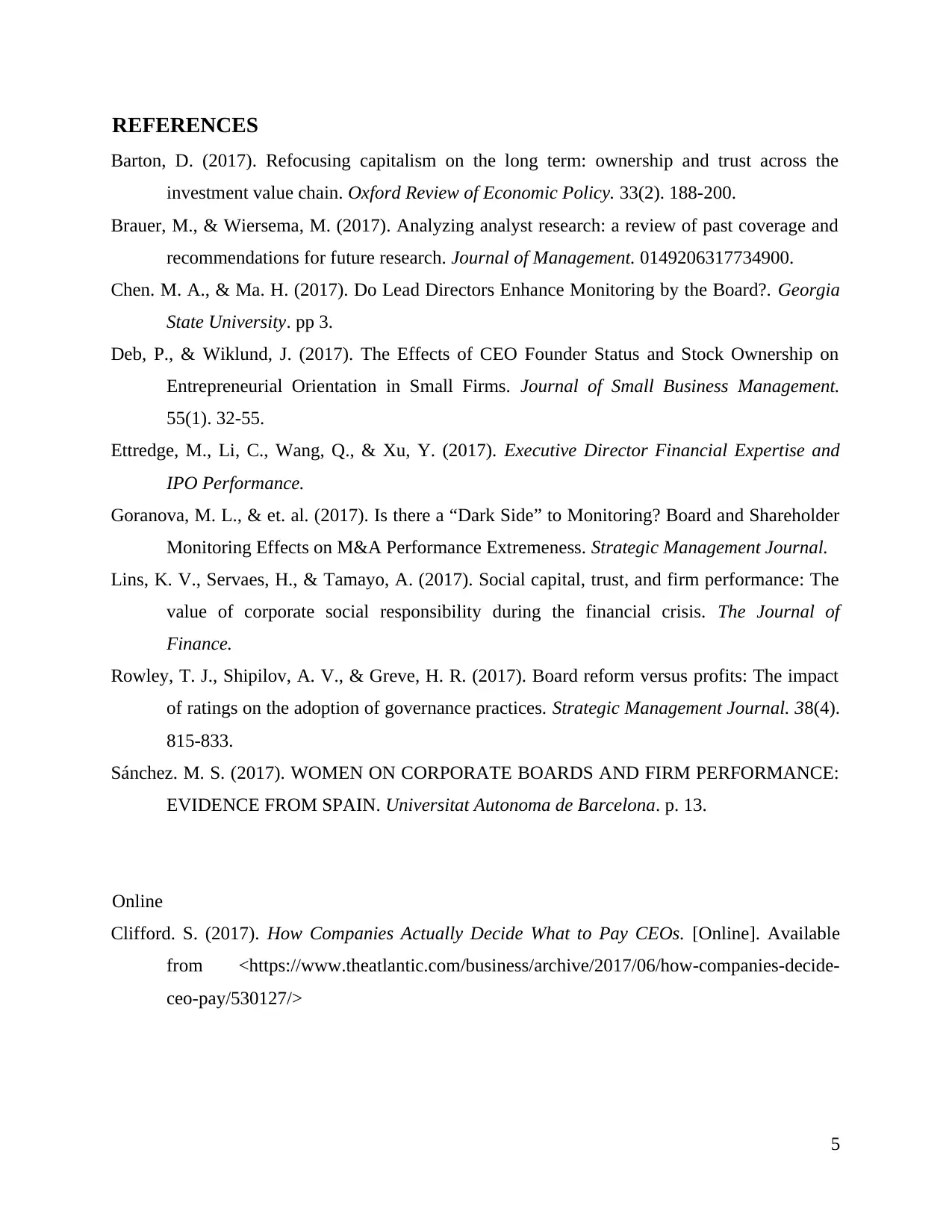
REFERENCES
Barton, D. (2017). Refocusing capitalism on the long term: ownership and trust across the
investment value chain. Oxford Review of Economic Policy. 33(2). 188-200.
Brauer, M., & Wiersema, M. (2017). Analyzing analyst research: a review of past coverage and
recommendations for future research. Journal of Management. 0149206317734900.
Chen. M. A., & Ma. H. (2017). Do Lead Directors Enhance Monitoring by the Board?. Georgia
State University. pp 3.
Deb, P., & Wiklund, J. (2017). The Effects of CEO Founder Status and Stock Ownership on
Entrepreneurial Orientation in Small Firms. Journal of Small Business Management.
55(1). 32-55.
Ettredge, M., Li, C., Wang, Q., & Xu, Y. (2017). Executive Director Financial Expertise and
IPO Performance.
Goranova, M. L., & et. al. (2017). Is there a “Dark Side” to Monitoring? Board and Shareholder
Monitoring Effects on M&A Performance Extremeness. Strategic Management Journal.
Lins, K. V., Servaes, H., & Tamayo, A. (2017). Social capital, trust, and firm performance: The
value of corporate social responsibility during the financial crisis. The Journal of
Finance.
Rowley, T. J., Shipilov, A. V., & Greve, H. R. (2017). Board reform versus profits: The impact
of ratings on the adoption of governance practices. Strategic Management Journal. 38(4).
815-833.
Sánchez. M. S. (2017). WOMEN ON CORPORATE BOARDS AND FIRM PERFORMANCE:
EVIDENCE FROM SPAIN. Universitat Autonoma de Barcelona. p. 13.
Online
Clifford. S. (2017). How Companies Actually Decide What to Pay CEOs. [Online]. Available
from <https://www.theatlantic.com/business/archive/2017/06/how-companies-decide-
ceo-pay/530127/>
5
Barton, D. (2017). Refocusing capitalism on the long term: ownership and trust across the
investment value chain. Oxford Review of Economic Policy. 33(2). 188-200.
Brauer, M., & Wiersema, M. (2017). Analyzing analyst research: a review of past coverage and
recommendations for future research. Journal of Management. 0149206317734900.
Chen. M. A., & Ma. H. (2017). Do Lead Directors Enhance Monitoring by the Board?. Georgia
State University. pp 3.
Deb, P., & Wiklund, J. (2017). The Effects of CEO Founder Status and Stock Ownership on
Entrepreneurial Orientation in Small Firms. Journal of Small Business Management.
55(1). 32-55.
Ettredge, M., Li, C., Wang, Q., & Xu, Y. (2017). Executive Director Financial Expertise and
IPO Performance.
Goranova, M. L., & et. al. (2017). Is there a “Dark Side” to Monitoring? Board and Shareholder
Monitoring Effects on M&A Performance Extremeness. Strategic Management Journal.
Lins, K. V., Servaes, H., & Tamayo, A. (2017). Social capital, trust, and firm performance: The
value of corporate social responsibility during the financial crisis. The Journal of
Finance.
Rowley, T. J., Shipilov, A. V., & Greve, H. R. (2017). Board reform versus profits: The impact
of ratings on the adoption of governance practices. Strategic Management Journal. 38(4).
815-833.
Sánchez. M. S. (2017). WOMEN ON CORPORATE BOARDS AND FIRM PERFORMANCE:
EVIDENCE FROM SPAIN. Universitat Autonoma de Barcelona. p. 13.
Online
Clifford. S. (2017). How Companies Actually Decide What to Pay CEOs. [Online]. Available
from <https://www.theatlantic.com/business/archive/2017/06/how-companies-decide-
ceo-pay/530127/>
5
1 out of 7
Related Documents
Your All-in-One AI-Powered Toolkit for Academic Success.
+13062052269
info@desklib.com
Available 24*7 on WhatsApp / Email
![[object Object]](/_next/static/media/star-bottom.7253800d.svg)
Unlock your academic potential
Copyright © 2020–2025 A2Z Services. All Rights Reserved. Developed and managed by ZUCOL.





